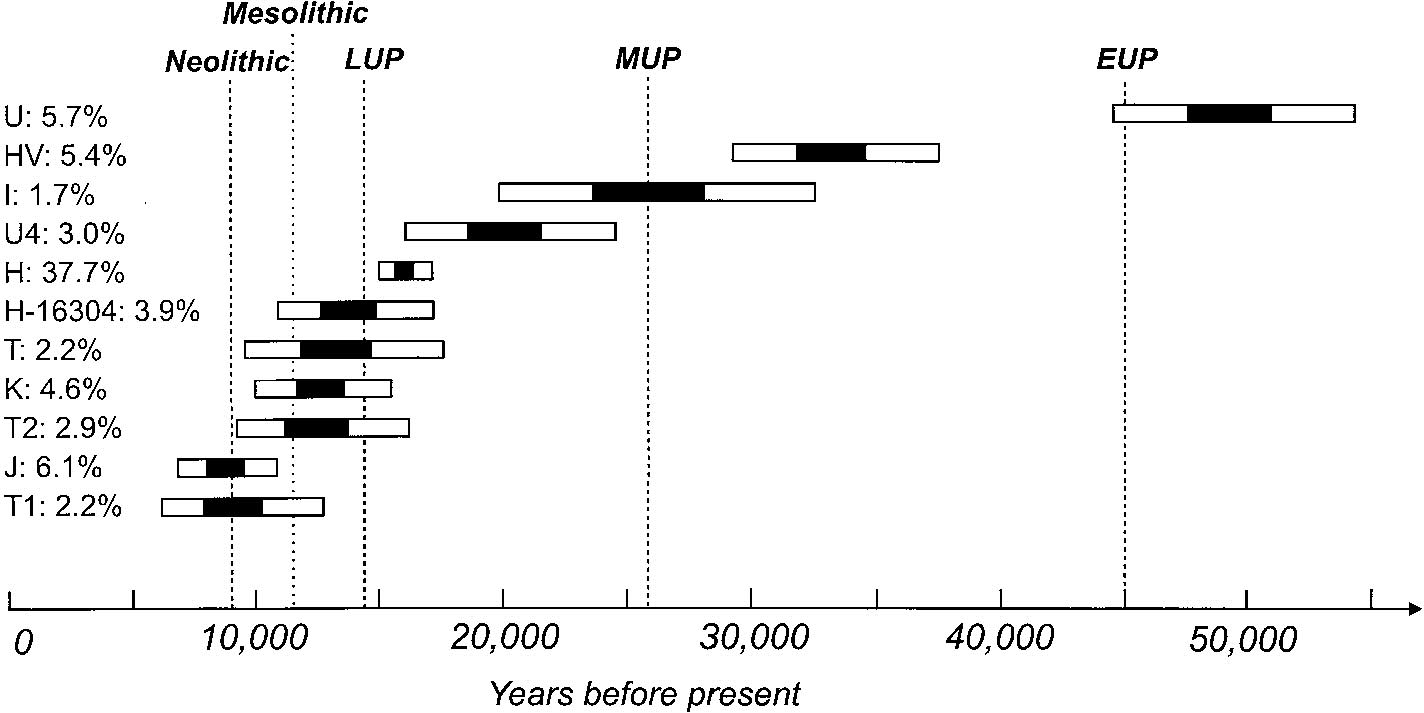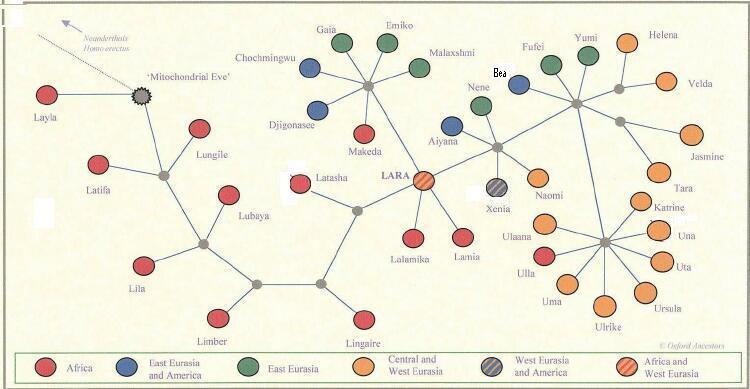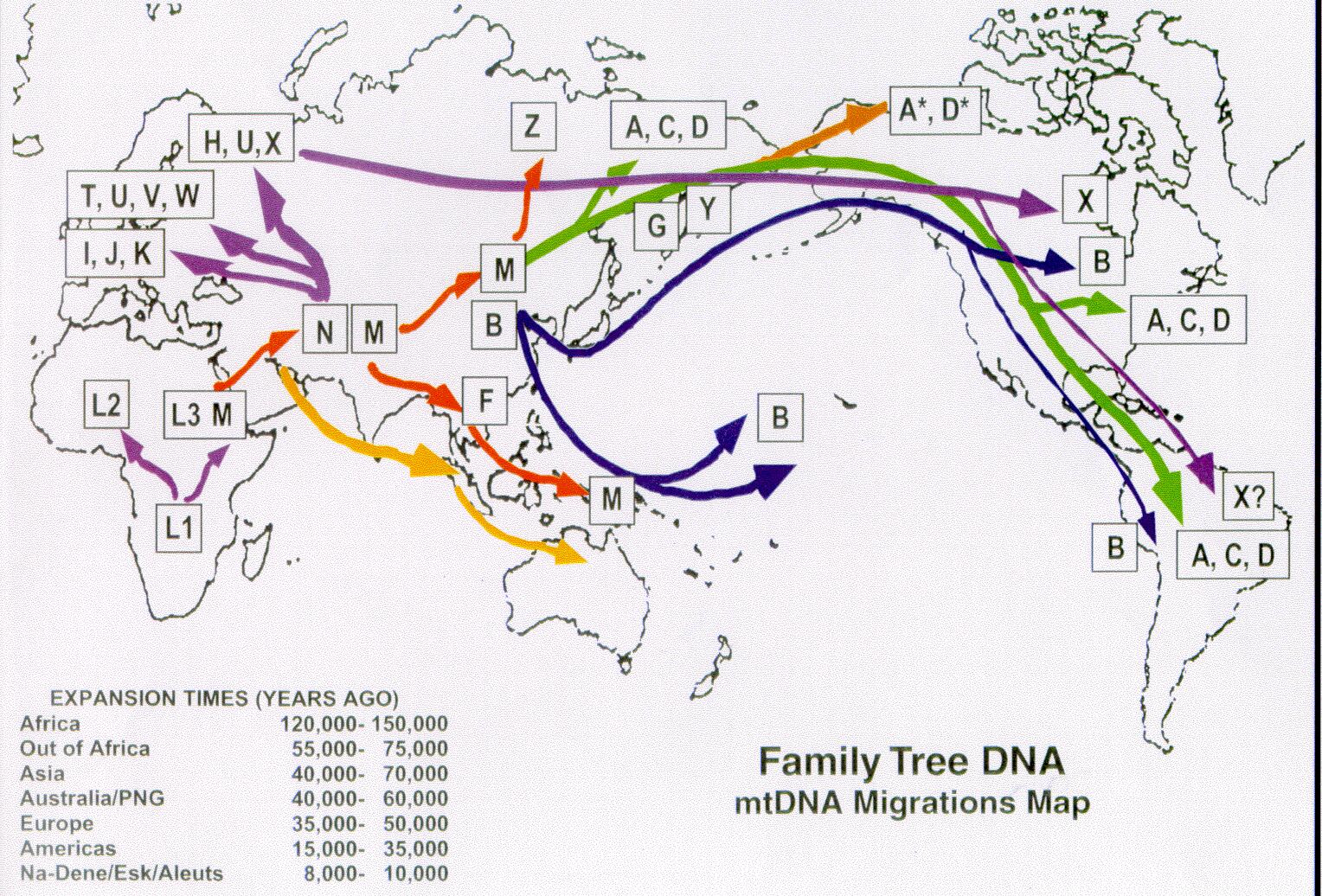

Human mitochondria (the energy-producing organelles outside the nucleus of cells) DNA is passed down generations only through females. Thus, testing of the DNA in mitochondria can aid in establishing matrilineal lines. (Establishing matrilineal lines with documents is more difficult than for patrilineal lines in most European lines because the surnames of females are lost in naming children; exceptions are Spanish and Portuguese.)
mtDNA is a circular structure composed of 16,569 nucleotides, also called base pairs (13 genes). (It is believed that the mitochondria were originally parasitic bacteria which, through evolution, became symbiotic with the human cell and then became an integral part of the cell; bacterium DNA is circular.) There is a 540 base-pair section labeled 16001-16540 that evolves faster than other sections, so it is used to distinguish human groups that evolved separately. In the table below there are two sets of four rows that list the 540 base pairs: the first row starts at position 16001 and ends at 16100, the second row encompasses 16101-16200, the third row encompasses 16201-16300, the fourth row encompasses 16301-16400, the fifth row encompasses 16401-16500 and the fourth row encompasses 16501-16540. The Cambridge Reference Sequence (CRS) is the sequence of base pairs for a specific person to which all other persons are compared.
Average number of mtDNA base pairs differences between two humans is about 10-66. The HVR1 test indicates to which of the major 36 World (10 for 99% of Europeans) haplogroups you belong. This could be millions of people! If it is a rare haplogroup, it could be a much smaller group. Mine is haplogroup I (Iris), in which are <2% of Europeans. This is most helpful for genealogy when you think you are related to someone through your maternal line. Test HVR1 for both to see if they are the same; if the same there is a 50% probability that you have a common ancestor 52 generations ago or less. For better resolution, do the HVR2 test; if still the same there is a 50% probability that you have a common ancestor 28 generations ago or less. So, it is not accurate enough for genealogy.
Full sequencing of mtDNA is equivalent to 41 markers on the Y-chromosome for genealogical use in the strict female line. It is difficult to follow a maternal line back many generations, since surnames usually change each generation.
I have had my mtDNA tested (HVR1 low-resolution test) by Family Tree DNA. I am in haplogroup I, which is defined by mutations:
| 16129A | 16223T | 16391A |
relative to CRS; I have 3 additional mutations relative to CRS:
| 16172C | 16311C | 16519C |
My result is given in the table just below the base pairs with the differences from the CRS in bold red. (There are four different base pairs labeled by Adenine, Cytosine, Guanine and Thymine.)
Another way to show it:
HVR1 |
Reference |
Sequence |
Position |
CRS |
My Result |
16129 |
G |
A |
16172 |
T |
C |
16223 |
C |
T |
16331 |
T |
C |
16391 |
G |
A |
16519 |
T |
C |
My HRV1 results was so rare that I decided to have the HRV2 measurement made. My relative mutations with the CRS are
| 73G |
199C |
203A |
204C |
250C |
263G |
309.1C (insertion
of a C after the 309 location) |
|
309.2C (insertion
of a C after the previous insertion) |
|
315.1C (insertion
of a C after the 315 location) |
|
455.1T (insertion
of a T after the 455 location) |
|
522-(base pair at 522
location is missing) |
|
523- (base pair at the 523 location is missing) |
|
573.1C (insertion
of a C after the 573 location) |
|
573.2C (insertion
of a C after the previous insertion) |
|
The 199C and 250C mutations define the haplogroup I1a, along with the three HVR1 mutations given above (16129A, 16223T, 16291A).
The following table shows the CRS and my mutations below the relevant location in red.
Another way to show it:
HVR2 |
Reference |
Sequence |
Position |
CRS |
My Result |
73 |
A |
G |
199 |
T |
C |
203 |
G |
A |
204 |
T |
C |
250 |
T |
C |
263 |
A |
G |
309.1 |
C |
|
309.2 |
C |
|
315.1 |
C |
|
455.1 |
T |
|
522 |
C |
- |
523 |
A |
- |
573.1 |
C |
|
573.2 |
C |
So, in total for both HVR1 and HVR2, my mtDNA has 18 relative mutations with CRS.
Differences |
from |
CRS |
750G |
1438G |
1719A |
2706G |
3447G |
3990T |
4529T |
4769G |
6734A |
7028T |
8251A |
8616T |
8860G |
9947A |
10034C |
10238C |
10398G |
10915C |
11719A |
12501A |
12705T |
13780G |
14766T |
15043A |
15326G |
15924G |
I am in mtDNA haplogroup I1a, as shown in http://www.journals.uchicago.edu/AJHG/journal/issues/v68n6/002593/fg2.h.gif and http://www.ancientrootsresearch.com/Hap-I/Members.html#News. Note at the top left the mutations at locations 16129 and 16391 define the haplogroup, and the mutations at locations 16172 and 16311 define the I1 branch of I. In addition, I have mutations at locations 16085 and 16223; the 16223 one is the branching off from the African outgroup; the 16085 one defines a subbranch of I1 called I1a. Note the genetic closeness of the I haplogroup to the X haplogroup, which is Asian and Native American (the late arrivals). Perhaps this is part of the reasons my Biogeographice genetic test (DNAPrint) show 17% East Asian.
| Age
ranges for some founding haplogroups |
 |
| Note that, in this study, haplogroup I, where my mtDNA lies, is 1.7% of the European population in this study and originated c26,000 ybp. Haplogroup I is found in north and east Europe, the Near East, the Caucasus, Egypt, Arabia and Northwest Africa..Haplogroup I is a subgroup of the Xenia haplogroup in Bryan Syke's book The Seven Daughters of Eve. |
 |
| Migration map for founding haplogroups, courtesy of
Family Tree DNA Note that haplogroup I originated in west-central Eurasia, as did many other haplogroups. (See Bryan Syke's book The Seven Daughters of Eve, p.275.) |
 |
The major haplogroups for Europeans are H, J, U, T, K, X, V and I. (See Bryan Syke's book The Seven Daughters of Eve)
| haplogroup | % of Europeans | years before present | origin |
| H (Helena) | ~47 | ~20,000 | South France |
| J (Jasmine) | ~17 | ~10,000 | Middle East |
| U (Ursula) | ~11 | ~45,000 | Greece |
| T (Tara) | ~9 | ~17,000 | Tuscany |
| K (Katrina) | ~6 | ~15,000 | North Italy |
| X (Xenia) | ~6 | ~25,000 | Georgia, Asia |
| V (Velda) | ~5 | ~17,000 | North Spain |
| I (Iris) | <2 | ~26,000 | Iran |
For a more recent excellent discourse on mtDNA compared to Y-chromosome tests, see Bryan Sykes, Adam's Curse: A Future Without Men.
See the haplogroup I web page of Bonnie Schrack for some details about the mother of I.
| Matrilineal line for the oldest sister of L. David Roper |
| I (Iris) haplogroup mother (b 26,000±3,000 BC) |
| (Intervening 1000±150 generations) |
| Sarah Hubbard (b c1700 VA d c1749 VA) |
| Sarah Echols (b 1731/5 ,Henry,VA d NC) |
| Jensy Rowden (1768 VA d 1820 ,Pittsylvania,VA) |
| Nancy Witcher (b 1812 VA d >1880 Marshall,Saline,MO) |
| Elizabeth Frances King (b 1841 IL d >1885 Marshall,Saline,MO) |
| Jeanetta Mildred Thomas (b 1860 St. Louis,St. Louis,Mo d 1949 Tulare,Tulare,CA) |
| Cecil May Donnell (b1891 Marshall,Saline,Mo d 1975 Santa Ana,Orange,CA) |
| Eva Lucille Franklin (b1908 Roll,Roger Mills,Ok d 1985 Shattuck,Ellis,OK) |
| Marjorie Mae Roper (b1929 Fort Worth,Tarrant,TX d 1998 Ochelata,Washington,OK) |
| Ronda Beth Wieden (b 1955 Winona,Winona,MN) |
| Jennifer Beth Ganer (b 1976 Blackwell,Kay,OK) |
View all known female descendants (and their husbands) of Sarah Hubbard (b c1700 VA d c1749 VA).
See http://herkules.oulu.fi/isbn9514255674/html/x287.html for a tutorial about mtDNA.
All of the above has to do with the non-coding region of mtDNA, called the "control region" or the "D-loop", which encompasses the following:
Thus there are at least 1050 base pairs in the control region. Actually the D-loop has 1121 bp, so there are 71 bp in the D-loop not included in HVR1 and HVR2 and there are 16,569-1121=14,448 bp in the remaining coding region. Recent work has indicated that mutations in the coding region are related to aging. It appears that the following would be two excellent experiments to perform to check out this hypothesis:
One can now get a full sequencing of mtDNA: http://www.familytreedna.com/description.html#mtFullSequence. I did this; see above.
At the 2005 2nd International Conference of Genetic Genealogy (ICGG) the follow information was provided:
| Probability for a Most Recent Common
Ancestor Approximate Comparison |
|
| Y-Chromosome | mtDNA |
| 1.5 markers | 540 base pairs (HVR1) |
| 2.5 markers | 1,050 base pairs (HVR2) |
| 12 markers | 4,800 base pairs |
| 25 markers | 10,000 base pairs |
| 37 markers | 14,800 base pairs |
| 41 markers | 16,569 base pairs* |
| *Full mtDNA | |
So, a full mtDNA comparison for two individuals in a female line would give a tighter comparison of their relationship than does 37 Y markers in a male line. However, there are diseases associated with some genes on mtDNA. So, measuring the full mtDNA in order to compare two females to see if they are in the same female line might reveal that one or both are susceptible to a specific disease. That is, private information might be revealed.
Also, at the 2nd ICGG it was stated that using autosomal DNA for genealogy would not yield useful information any further back than 4 generations. It was predicted than within the next decade a full genome sequence would cost about $1,000. In 2005 it costs about $2x10^6. In five years it will be about $10,000.
Roper
Genetics Project
Franklin Genetics
Project
Little/Klein/Cline Genetics
Project